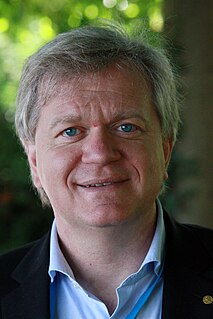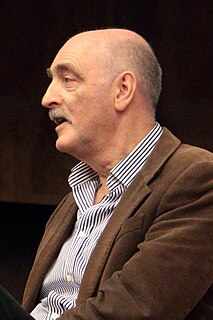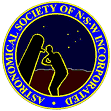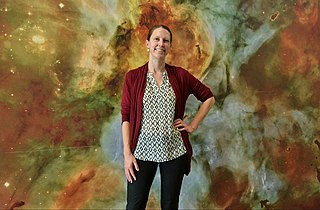Related Research Articles

Marc Aaronson was an American astronomer.

The American Astronomical Society is an American society of professional astronomers and other interested individuals, headquartered in Washington, DC. The primary objective of the AAS is to promote the advancement of astronomy and closely related branches of science, while the secondary purpose includes enhancing astronomy education and providing a political voice for its members through lobbying and grassroots activities. Its current mission is to enhance and share humanity's scientific understanding of the universe as a diverse and inclusive astronomical community.

Michel Gustave Édouard Mayor is a Swiss astrophysicist and professor emeritus at the University of Geneva's Department of Astronomy. He formally retired in 2007, but remains active as a researcher at the Observatory of Geneva. He is co-laureate of the 2019 Nobel Prize in Physics along with Jim Peebles and Didier Queloz, and the winner of the 2010 Viktor Ambartsumian International Prize and the 2015 Kyoto Prize.

Bartholomeus Jan "Bart" Bok was a Dutch-American astronomer, teacher, and lecturer. He is best known for his work on the structure and evolution of the Milky Way galaxy, and for the discovery of Bok globules, which are small, densely dark clouds of interstellar gas and dust that can be seen silhouetted against brighter backgrounds. Bok suggested that these globules may be in the process of contracting, before forming into stars.

Bryan Malcolm Gaensler is an Australian astronomer based at the University of Toronto. He studies magnetars, supernova remnants, and magnetic fields. In 2014, he was appointed as Director of the Dunlap Institute for Astronomy & Astrophysics at the University of Toronto, after James R. Graham's departure. He is currently the co-chair of the Canadian 2020 Long Range Plan Committee with Pauline Barmby.

Brian Paul Schmidt is the Vice-Chancellor of the Australian National University (ANU). He was previously a Distinguished Professor, Australian Research Council Laureate Fellow and astrophysicist at the University's Mount Stromlo Observatory and Research School of Astronomy and Astrophysics. He is known for his research in using supernovae as cosmological probes. He currently holds an Australia Research Council Federation Fellowship and was elected a Fellow of the Royal Society (FRS) in 2012. Schmidt shared both the 2006 Shaw Prize in Astronomy and the 2011 Nobel Prize in Physics with Saul Perlmutter and Adam Riess for providing evidence that the expansion of the universe is accelerating, making him the only Montana-born Nobel laureate.
Lisa Jennifer Kewley is a Professor and Director of the ARC Centre of Excellence for All Sky Astrophysics in 3-D and ARC Laureate Fellow at the Australian National University College of Physical and Mathematical Sciences. Specialising in galaxy evolution, she won the Annie Jump Cannon Award in Astronomy in 2005 for her studies of oxygen in galaxies, and the Newton Lacy Pierce Prize in Astronomy in 2008. In 2014 she was elected a fellow of the Australian Academy of Science. In 2020 she received the James Craig Watson Medal. In 2021 she was elected as an international member of the National Academy of Sciences.
Australian Aboriginal astronomy is a name given to Aboriginal Australian culture relating to astronomical subjects – such as the Sun and Moon, the stars, planets, and the Milky Way, and their motions on the sky.
Priscilla Fairfield Bok was an American astronomer and the wife of Dutch-born astronomer Bart Bok, Director of Mount Stromlo Observatory in Australia and later of Steward Observatory in Arizona, US. Their harmonious marriage accompanied the four decades of their close scientific collaboration, in which "it is difficult and pointless to separate his achievements from hers". They co-authored a number of academic papers on star clusters, stellar magnitudes, and the structure of the Milky Way galaxy. The Boks displayed great mutual enthusiasm for explaining astronomy to the public: described as "salesmen of the Milky Way" by The Boston Globe, their general interest book The Milky Way went through five editions and was said to be "one of the most successful astronomical texts ever written".
The Astronomical Society of Australia (ASA) is the professional body representing astronomers in Australia. Established in 1966, it is incorporated in the Australian Capital Territory. Membership of the ASA is open to people "capable of contributing to the advancement of astronomy or a closely related field". This means that the members are mainly active professional astronomers and postgraduate students. Some retired astronomers and distinguished amateur astronomers are also members, and several organisations are corporate members of the Society. The ASA currently has around 600 members. It publishes a peer-reviewed journal, Publications of the Astronomical Society of Australia.

Geraint Francis Lewis is a Welsh astrophysicist, who is best known for his work on dark energy, gravitational lensing and galactic cannibalism. Lewis is a Professor of Astrophysics at the Sydney Institute for Astronomy, part of the University of Sydney's School of Physics. He is head of the Gravitational Astrophysics Group. He was previously the Associate Head for Research at the School of Physics, and held an Australian Research Council Future Fellowship between 2011 and 2015. Lewis won the 2016 Walter Boas Medal in recognition of excellence in research in Physics. In 2021, he was awarded the David Allen Prize of the Astronomical Society of Australia for exceptional achievement in astronomy communication.

Frederick Garnett "Fred" Watson AM is an English-born astronomer and popular scientist in Australia. In 1995 Watson became astronomer in charge of the Australian Astronomical Observatory, but is best known for his work with science outreach, for which he has written many books, as well as musical and choral works. On top of his many nationwide radio slots with the ABC, Watson has also been a frequent guest on The Project. In January 2010, Watson was made a member of the Order of Australia for service to astronomy, particularly the promotion and popularisation of space science through public outreach. He is a frequent guest on space nuts podcast with Andrew Dunkley.
Lennox Lauchlan Cowie FRS is a British astronomer, and professor at the Institute for Astronomy, University of Hawaii.

Ragbir BhathalFRSN, FRAS, FSAAS is an Australian astronomer and author, currently based at the Western Sydney University (WSU), Australia. He is known for his work on Optical Search for Extra-Terrestrial Intelligence (OSETI). He did his Ph.D. in magnetism at the University of Queensland. He has served as a UNESCO consultant on science policy for the ASEAN group of nations, as an Adviser to the Federal Minister for Science and was the Project Director for the million dollar Sydney Observatory restoration building program. Bhathal also designed and built the twin dome Campbelltown Rotary Observatory at the WSU Campbelltown Campus and was Patron of Macarthur Astronomical Society from 1997 to 2011.

Lisa Harvey-Smith is a British-Australian astrophysicist, Australia's Women in STEM Ambassador and a Professor of Practice in Science Communication at the University of NSW. Her research interests include the origin and evolution of cosmic magnetism, supernova remnants, the interstellar medium, massive star formation and astrophysical masers. For almost a decade Harvey-Smith was a research scientist at Australia’s Commonwealth Scientific and Industrial Research Organisation (CSIRO), including several years as the Project Scientist for the Square Kilometre Array Pathfinder and later Project Scientist for the Australian Square Kilometre Array Pathfinder (ASKAP) Telescope.

The Astronomical Society of New South Wales (ASNSW) is an amateur astronomy club in the state of New South Wales, Australia. It was founded in 1954 and it has over 400 members.

Heather A. Knutson is an astrophysicist and professor at California Institute of Technology in the Division of Geological and Planetary Sciences. Her research is focused on the study of exoplanets, their composition and formation. She won the American Astronomical Society's Newton Lacy Pierce Prize in Astronomy for her work in exoplanetary atmospheres.
Betty Louise Turtle was an Australian astronomer and physicist. In 1971, with her colleague Paul Murdin, she identified the powerful X-ray source Cygnus X-1 as the first clear candidate for a black hole.

Jonathan (Joss) Bland-Hawthorn is a British-Australian astrophysicist. He is a Laureate professor of physics at the University of Sydney, and director of the Sydney Institute for Astronomy.
References
- ↑ "The Bok Prize". Astronomical Societyof Australia. Retrieved 26 September 2020.
- ↑ Pope, Benjamin (2012). Dancing in the Dark: Kernel Phase Interferometry of Ultracool Dwarfs (PDF). Sydney Institute for Astronomy School of Physics University of Sydney. p. 68. Archived from the original (PDF) on 2016-03-22. Retrieved 2016-06-11.